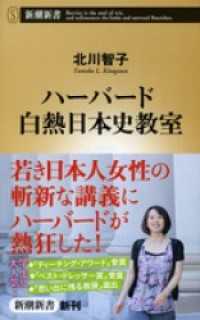- ホーム
- > 洋書
- > 英文書
- > Business / Economics
Full Description
The Economic and Financial Impacts of the COVID-19 Crisis Around the World: Expect the Unexpected provides an informed, research-based in-depth understanding of the COVID-19 crisis, its impacts on households, nonfinancial firms, banks, and financial market participants, and the effectiveness of the reactions of governments and policymakers in the United States and around the world. It provides reflections and perspectives on the social costs and benefits of various policies undertaken and a toolkit of preventive measures to deal with crises beyond the COVID-19 crisis.
Authors Allen N. Berger, Mustafa U. Karakaplan, and Raluca A. Roman apply their expertise to the research and data on the COVID-19 economic crisis as well as draw on their own rich research experience. They take a holistic approach that compares and contrasts this crisis with other economic and financial crises and assesses economic and financial behavior and government policies in the booms before crises and the aftermaths following them, as well as the crises themselves. They do all this with a keen eye on "Expecting the Unexpected” future crises, and policies that might anticipate them and provide better outcomes for society.
Contents
Part I. Focus of the book and other introductory materials
Introduction to Part I
1. Introduction to the economic and financial impacts of the COVID-19 crisis and related topics
2. The COVID-19 pandemic versus past epidemics, pandemics, and other health crises
3. The COVID-19 pandemic as a "black swan" event - comparisons with natural disaster shocks
4. Conceptual framework for economic, banking, and financial market cycles featuring crises
5. Putting the COVID-19 crisis into context - comparison with earlier global crises
Part II. Empirical evidence on economic and financial effects of COVID-19 crisis around the world
Introduction to Part II
6. Empirical evidence on the economic effects of COVID-19 crisis on national and local economies
7. Empirical evidence on the economic effects of COVID-19 crisis on households
8. Empirical evidence on the economic effects of COVID-19 crisis on nonfinancial firms
9. Empirical evidence on the effects of COVID-19 crisis on banks
10. Empirical evidence on the economic effects of COVID-19 crisis on financial markets
Part III. Government policy reactions to the COVID-19 crisis and their economic and financial effects around the world
Introduction to Part III
11. Putting the COVID-19 crisis policies into context - The Paycheck Protection Program (PPP) versus the Troubled Asset Relief Program (TARP) during the Global Financial Crisis (GFC)
12. Other policy reactions to the COVID-19 crisis in the U.S. and their effects on local economies, households, nonfinancial firms, banks, and financial markets
13. Policy reactions to the COVID-19 crisis in the rest of the world and their effects on economies, households, nonfinancial firms, banks, and financial markets
Part IV. The extraordinary recoveries in real economies, banking sectors, and financial markets
Introduction to Part IV
14. U.S. evidence
15. Evidence from the rest of the world
Part V. Economic and financial effects during the aftermath of COVID-19 crisis around the world
Introduction to Part V
16. Continuations versus cutbacks of COVID-19 crisis policies in the crisis aftermath
17. Aftermath effects on national and local economies
18. Aftermath effects on households
19. Aftermath effects on nonfinancial firms
20. Aftermath effects on banks
21. Aftermath effects on financial markets
Part VI. Lessons learned from the COVID-19 crisis
Introduction to Part VI
22. Expect the unexpected and prepare for future crises
-

- 電子書籍
- ブルー ハワイ
-

- 電子書籍
- 猫の手でもよろしければ レジーナCOM…
-

- 電子書籍
- Eクライシス(3) あしたきみに優しく…
-

- 電子書籍
- 片翼のラビリンス(7) フラワーコミッ…
-

- 電子書籍
- ハーバード白熱日本史教室 新潮新書



